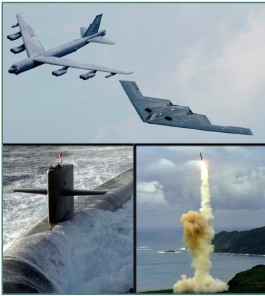
Today's U.S. nuclear triad
As the Pentagon’s nuclear arsenal continues to shrink, so does the rationale for maintaining the Cold War’s nuclear triad that still has nuclear weapons spread among subs, bombers and land-based missiles. But as its components age, advocates come up with neat schemes to preserve their slice of the triad. If bombers are doomed, the latest proposal from inside the Air Force suggests, let’s simply shift our bombers’ share of nuclear weapons to our yet-to-be-bought F-35 fighters. Neat trick: not only does that preserve one of our legs of the triad, the Air Force thinking goes, but it throws a life preserver to the troubled F-35 program.
The declining nuclear arsenal — mandated by a new arms pact with the Russians — makes the triad more costly, per warhead, with the passage of time. Air Force Colonel David Baylor, in the latest issue of the Air Force’s own Strategic Studies Quarterly,wonders what will happen as the U.S. nuclear arsenal continues to wane. He warns that his own service may soon be stripped of the bomber leg of the nuclear triad. “Even though the Air Force is revitalizing its nuclear enterprise, the nuclear strategic bombing mission may be lost,” he writes. “…the aging US bomber fleet and a bomber on the drawing board would be easy force structure modification targets, either for `efficiencies’ or negotiations.” Poof! The triad would become a dyad.
The triad’s logic made more sense during the Cold War (unless you’d visited Russia). The thinking was that if the crafty Soviets could wipe out one delivery system, there would be two remaining to deter them. Or (Dr. Strangelove — stat!) if they could eliminate a pair of them, there would still be a lone leg left in reserve to keep the Russians from launching that initial bolt out of the blue. Or if one of the legs broke because of U.S. incompetence, there would still be nuclear weapons ready to use. Bruce Blair reported the other day that the world’s pursuit of a nuclear nirvana, or atomic stability, or an A-edge, or whatever you want to call it, is costing the world about $1 trillion a decade.
Like all good Cold War hangovers, the continued existence of the nuclear triad is testament to the barnacled thinking of the nation’s national-security establishment. The fact that Administrations repeatedly endorse it reflects weaknesses of both political parties: Democrats break out in a cold (war) sweat whenever it’s suggested they’re imperiling national security, and Republicans can’t be the party of peace through strength unless the triad continues to bristle under the seas, on the Great Plains and on air bases (although the bombers are no longer on strip alert).
The U.S. currently has 1,800 nuclear warheads on 882 deployed launchers (i.e., ICBMs, submarine-launched ballistic missiles, and heavy bombers), while Russia has 1,537 warheads on 521 deployed launchers. Under the New START treaty that took effect in February, each side will have to cut its deployed nuke force to 1,550 spread among 700 deployed launchers by 2018.
So what would happen without nuclear bombers? “The loss of bombers would lead to a dyad of US nuclear weapons and eliminate an important signaling capability,” the Air Force’s Baylor writes. “Our bomber forces can signal willingness (an important part of deterrence) to use nuclear weapons and unlike other legs of the triad, bombers can be both launched and recalled. Without a bomber force, this traditional signaling mechanism could be lost.”
So what’s a nuclear-bomberless nation to do? “To maintain some semblance of a triad and provide the necessary deterrence effects and security for our allies, the fighter community could ultimately pick up more of the airborne nuclear weapons delivery mission formerly provided by heavy bombers,” Baylor writes. “With the new [F-35] joint strike fighter becoming the Air Force’s weapons system of choice, its mandated nuclear weapons delivery capability will be a vital part of its mission.”
Did you see what just happened? The colonel, instead of advocating the nation can safely do away with at least one leg of its three-legged triad, called on the nation to keep all three — by simply shifting the Air Force aircraft role from the current B-2s and B-52s to the yet-to-be-built F-35, the most costly weapons program in the history of the world. Sure, the F-35’s rising cost and production delays are rendering it vulnerable to budget cutters, but turning it into the third leg of the triad would make it much tougher to kill.
In other words, the triad would live on. It would just be more isosceles than equilateral, apparently. After 30 years in this business, this is the part I don’t understand: why do we continue to cling to such outmoded ways of thinking? The science of deterrence has become black magic among the wizards of Armageddon (in Fred Kaplan’s memorable book title), allowing the Pentagon to buy, for decades yet to come, the 21st Century’s version of patent medicine. And the nation continues to let it get away with it.


